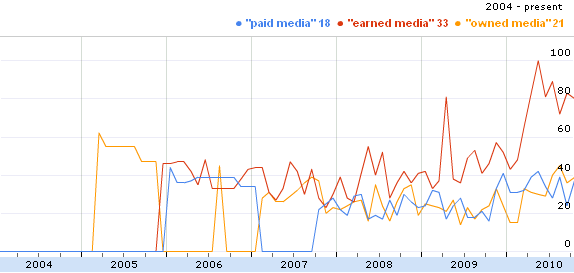 If you’ve been involved with interactive marketing in the past year, you’ve undoubtedly heard the terms “paid, earned and owned” media. Breaking down an online brand presence into these three categories can help define your marketing efforts, but how should you prioritize them?
If you’ve been involved with interactive marketing in the past year, you’ve undoubtedly heard the terms “paid, earned and owned” media. Breaking down an online brand presence into these three categories can help define your marketing efforts, but how should you prioritize them?
Sometimes it’s easy to bat around these kinds of buzzwords without having a solid understanding of what they truly mean. And it’s easy to dismiss the “paid, earned, and owned” triumvirate as so much marketing lingo, but bucketing these categories of brand-to-consumer engagement absolutely helps compartmentalize what would otherwise be difficult concepts to communicate. Sure enough, the growing popularity, and, hopefully, usefulness of these terms are illustrated in a simple Google trend (note the massive growth in 2010):
Fred Wilson’s post on earned media (which is the cause of that spike you see in April 2009), as well as Nokia’s Daniel Goodall’s piece on it, are definitive initial thoughts of the topic. Both are great reads. Without going too in depth, here is a quick breakdown of the three categories:
- Owned Media: Digital channels that brands control. These include your website, as well as Facebook Pages or Twitter Pages (though those might be considered “partially owned”).
- Paid Media: Aka “Bought Media.” This is pretty obvious, because it’s what the entire advertising industry is based on. You pay to leverage someone else’s distribution channel.
- Earned Media: This is the sticky one. Some say it’s PR. Some says it’s WOM. It’s essentially a channel that you have no control over because the crowd does.
A major point of confusion is that paid, earned, and owned are all separate channels bound to live in their own silos. That just isn’t true. Let’s take this summer’s Old Spice campaign that generated a massive amount of Earned Media buzz. There’s no doubt that it was a hilarious, clever and amazing execution, but it didn’t get popular just on merit alone — it started with a Super Bowl commercial.
In that example, Paid Media served as a catalyst, a spark, to ignite the Earned Media. This snowballed thanks to some well executed (and brilliantly coordinated) Owned Media.
A common problem with many “campaigns” is that they don’t look at all three buckets holistically. They treat each as separate initiatives, and that’s not cost effective. Paid Media has the benefit of immediacy. Earned Media has the benefit of influence. And Owned Media has the benefit of longevity. Each plays an important role.
Effective campaigns use all three forms of brand media together, with Paid Media used to ignite the Earned Media masses and maintained by the fire of Owned Media. Yes, you need the spark, but it just needs to be enough to light the kindling, so you can soon have a roaring flame.
The bottom line: if you see the benefits of your Paid Media campaign immediately disappear as soon as you turn off the spigot, then it’s time to reconsider your approach to Paid Media.
Photo: Thinkstock



Pingback: Advertising's Future Is 3 Simple Words: Paid. Owned. Earned. | Story Worldwide
Pingback: The Three Most Important Words in Advertising | Post Advertising
Pingback: Welcome to the Future of Advertising | Post Advertising
Pingback: Video: Welcome to the Future of Advertising | Story Worldwide
Pingback: What's the Point of Paid Media in Post-Advertising?